
Skip to main page content (AccessKey S)

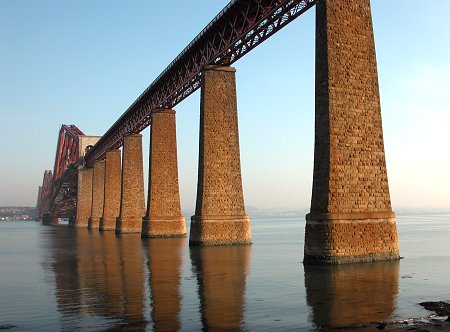 The Forth Rail bridge from South Queensferry |
The coming of the railways to Scotland initially had the effect of sidelining the traditional Forth ferry ports of North Queensferry and Queensferry or South Queensferry. From 1850, Edinburgh was connected to Perth by rail using a roll-on roll-off ferry directly linking Granton near Leith and Burntisland in Fife.
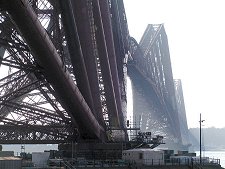 The Bridge from the North West |
|
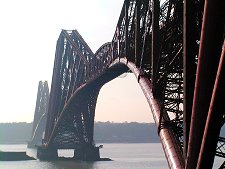 ...And from the North East |
|
 Both Bridges from South Queensferry |
|
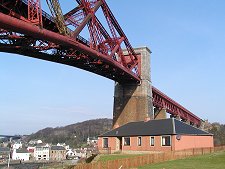 The Bridge over North Queensferry |
This all changed in 1879 when construction began on a railway suspension bridge. This was designed by Thomas Bouch, builder of the Tay Railway Bridge that had opened the previous year. The collapse of the Tay Bridge with large loss of life on 28 December 1879 brought a halt to work on Bouch's Forth Bridge with just part of one pier built.
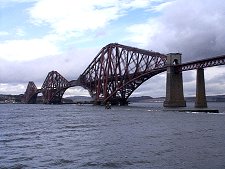 Bridge Seen from South Queensferry |
|
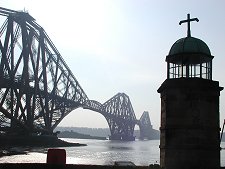 Rail Bridge and Lighthouse |
|
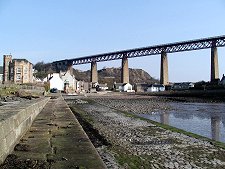 Bridge and Village from Slipway |
The completely redesigned bridge that was started in 1883 remains one of the world's most distinctive structures. It was opened by Edward, Prince of Wales on 4 March 1890. The bridge was constructed by Tancred-Arrol to a design by civil engineers Sir John Fowler and Benjamin Baker. In the aftermath of the Tay Bridge disaster the bridge was a testament to robust and conservative over-engineering.
The end result is a massive and remarkably imposing structure. It was built as three separate double cantilevers. When each had been constructed, they were linked together by 350ft long girder spans joined to the main structure of the bridge by huge pins. The whole bridge is balanced by 1000 ton counterweights on the outside of the outer cantilever structures.
The Forth Rail Bridge has an overall length of over 8,000ft. The towers reach a height of 361ft and trains cross the river at a height of 158ft. The total cost came to £3.2m, counting £250,000 for the abortive construction work on the earlier bridge. Construction involved the use of over 54,000 tons of steel and 6.5 million rivets.
During the seven years of construction, 4,000 men were employed, of whom 57 were killed in accidents. 8 more men were saved by safety boats positioned in the river under the working areas.
Although it was formally opened in 4 March 1890, the bridge was first used some weeks earlier, on 21 January. On that day two 1000ft long test trains each comprising a locomotive and 50 wagons, and each weighing 900 tons, rolled onto the bridge side by side from the south.
The bridge easily survived the test: though following the Tay disaster it is interesting to wonder about the feelings of the drivers of those first trains as they looked down at the river 150 feet below them. The bridge has been put to good use ever since. In 1907, 30,000 trains weighing a total of 14.5 million tons crossed the bridge. In contrast, in 2000, some 60,000 trains weighing a total of 10.5 million tons crossed the bridge.
When it was first constructed, the Forth Rail Bridge was regarded as the eighth wonder of the world. Familiarity breeds contempt, and it is easy to forget that this is a structure every bit as spectacular and remarkable as the Eiffel Tower, of which it can seem oddly reminiscent. The bridge can be viewed to really good effect from both North and South Queensferry: and the view from one of the many trains crossing it is equally worthwhile, especially of North and South Queensferry and of the Forth Road Bridge only a short distance to the west.
|
|
||||||
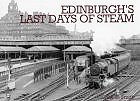 Edinburgh's Last Days of Steam: W.A.C. Smith
(October 2003). Railway services in Edinburgh began in earnest in 1846. This collection of
fifty-five photographs, all taken by the author, records the last decade or so of steam power in
the city. Edinburgh's Last Days of Steam: W.A.C. Smith
(October 2003). Railway services in Edinburgh began in earnest in 1846. This collection of
fifty-five photographs, all taken by the author, records the last decade or so of steam power in
the city.
|
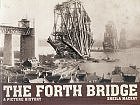 The Forth Bridge, A Picture History: Sheila MacKay
(March 2001). The Forth Bridge was the greatest engineering feat the Victorian world had ever
seen. The first large structure made of steel, it remains to this day one of the great achievements
of mankind. This book contains dramatic photographs of the bridge under construction. The Forth Bridge, A Picture History: Sheila MacKay
(March 2001). The Forth Bridge was the greatest engineering feat the Victorian world had ever
seen. The first large structure made of steel, it remains to this day one of the great achievements
of mankind. This book contains dramatic photographs of the bridge under construction.
|
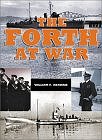 The Forth at War: William F. Hendrie (April
2002). The Forth and its estuary was very much a front line against Germany during both World
War I and World War II. This book includes photographs of the British battle fleet setting sail
from the Forth and the destruction caused by bombing. The Forth at War: William F. Hendrie (April
2002). The Forth and its estuary was very much a front line against Germany during both World
War I and World War II. This book includes photographs of the British battle fleet setting sail
from the Forth and the destruction caused by bombing.
|
||||